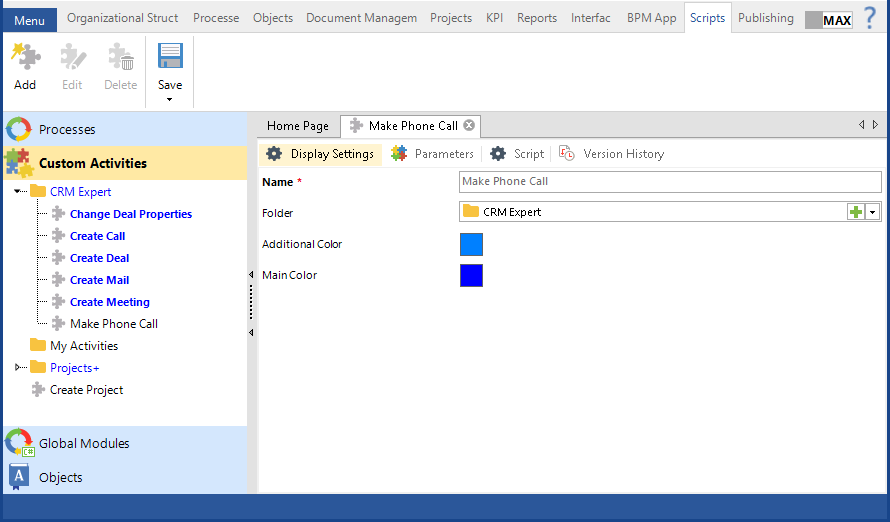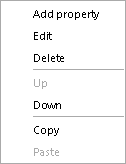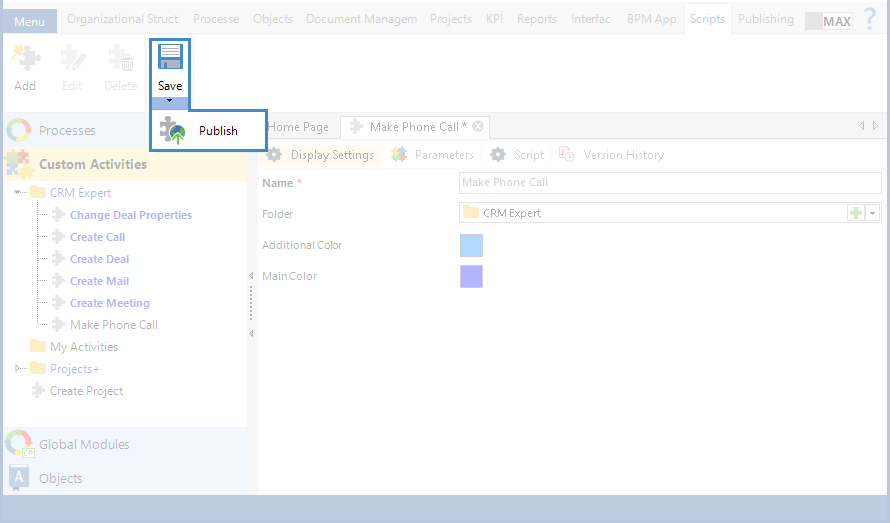The custom activity page allows you to select the following features: the color of the activity shape in the graphic model, activity group, and activity input/output settings and scripts. You can also publish the activity. Once it is published, it becomes available on a process page. You can find it in the Plug-Ins section of the graphic model side panel.
To open the page, go to the Scripts tab of ELMA Designer. Double-click on the custom activity name in the Custom Activities section. Select Edit in the context menu or click Edit in the toolbar.
The custom activity page features the following tabs: Display Settings, Parameters and Scripts.
Display Settings tab
On this tab, you can change the folder where the activity is stored, and select the activity colors.
|
|
|
Fig. 1. Custom Activity page. "Display Settings" tab.
|
Folder - folder or a group which stores the created custom activity in the list of custom activities and in the Plug-Ins section of the graphic model side panel on the process page. To change the folder, click the  button in the folder field. If there is no appropriate folder in the list, you can create a new one. Click
button in the folder field. If there is no appropriate folder in the list, you can create a new one. Click  .
.
Additional Color - color of the shape's outline in the process diagram.
Main Color - color of the shape in the process diagram.
Parameters tab
On this tab you can specify all the necessary parameters that will be used in the script. These parameters are properties of the custom activity. When you create a custom activity, the context of the process that will execute the script is not available. That is why for the custom activity you need to specify the names and types of properties that will be used in the script. When you place a custom activity on the process diagram, you must bind the custom activity properties to the process context variables.
|
|
|
Fig. 2. Custom Activity page. "Parameters" tab.
|
On this tab, you can specify the type of the property:
-
Input - this parameter passes a value to the script; the value is set manually or by a context variable;
-
Output - this parameter passes the value obtained in the script to the context variable of the process.
You can select the parameter's type by ticking its checkbox in the Input or Output columns.
The list of properties also contains:
-
Displayed Name of the property;
-
Property Name used in the custom activity's script;
-
Type of the property. According to this type you select the matching type of the context variable.
Context menu of the Parameters tab
You can manage the properties using the context menu (Fig. 3). To open it, right click in the list of properties.
|
|
|
Fig. 3. Custom Activity page. Context menu of the list of properties.
|
Add Property - adds a variable that will be used in the script. Specify the displayed name, type and description. You can also change the system name that will be used in scripts. Depending on the variable type, additional settings can become available.
Edit - opens a window where you can modify the current settings.
Delete - deletes a variable from the list of properties. Since a property is not a system object but simply belongs to the custom activity, it is deleted permanently.
The Up and Down options allow you to move the element in the list to improve readability.
With the Copy option you can copy the selected property to the clipboard. You can then add this property to the parameters of any other custom activity.
Scripts tab
On this tab you can create or modify the script used in the custom activity. Scripts are written in C#. Here you can find tools for writing scripts, such as syntax highlighting, IntelliSence (completion of functions and variables), links to assemblies and web services. For more information about working with scripts, see Process Scripts.
|
|
|
Fig. 4. Custom Activity page. "Scripts" tab.
|
Toolbar of the Custom Activity page.
When a custom activity page is open, the Save button appears in the toolbar. It is used to save the current changes in ELMA (Fig. 5). The saved changes are not applied until the custom activity is published. To publish the custom activity, click on the arrow underneath the Save button. The Publish button will appear. Publication of a custom activity does not require you to restart the server. Once published, you can use the custom activity for process modeling. When a new version of a custom activity is published, all the new process instances that include this activity will use the new version.
|
|
|
Fig. 5. Toolbar of the Custom Activity page.
|
Copyright © 2006–2019 ELMA




